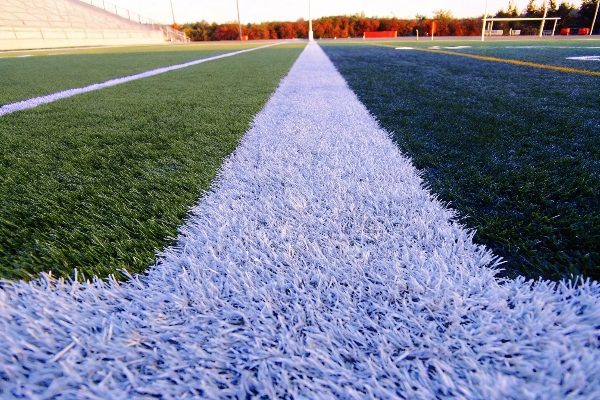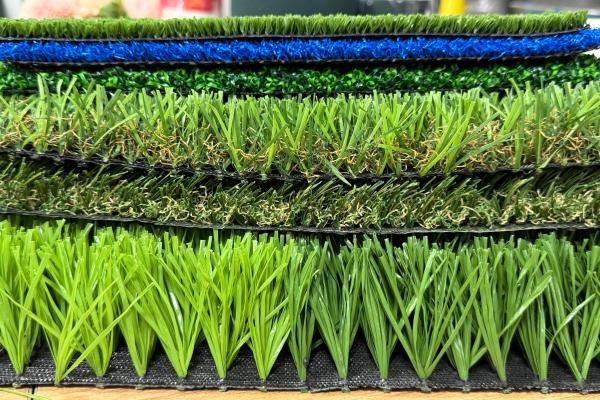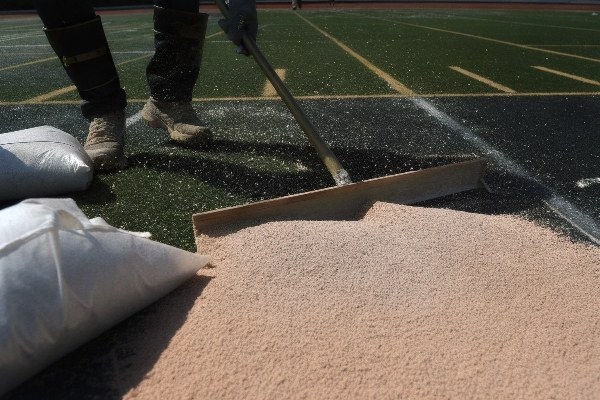Struggling with high maintenance costs and fields that are unusable after rain? Natural grass can be a major headache. Synthetic sports surfaces offer a durable, all-weather solution for your facility.
Synthetic sports surfaces are man-made turfs engineered to replicate natural grass. They consist of synthetic fibers, infill materials like sand or rubber, and a backing system. This design creates a durable, consistent, and low-maintenance playing area suitable for various sports in any weather condition.

That’s the simple explanation. But as an engineer who started on the factory floor, I can tell you there is so much more to it. I’ve seen firsthand how the quality of each component can make or break a sports field. The technology behind these surfaces is fascinating, and understanding it is key to making a smart investment. Let’s dive deeper into why these surfaces are becoming the standard for sports facilities around the world.
Why are more sports facilities choosing artificial turf1 over natural grass2?
Are you tired of canceled games due to muddy fields? Are high water and maintenance bills cutting into your budget? Artificial turf offers a reliable and cost-effective playing surface.
Facilities are switching to artificial turf for its superior durability and increased playtime. It dramatically cuts maintenance costs3 related to watering, mowing, and pesticides, while providing a consistent, safe playing surface that isn’t affected by weather.

When I talk to project managers and facility owners, their challenges are often the same. They need a surface that can handle heavy use without turning into a mud pit. They also have tight budgets. Artificial turf solves both problems. While the initial investment is higher, the long-term savings are significant. Let’s break down the key advantages.
Cost Savings Over Time
The upfront cost of an artificial turf field can seem high. However, natural grass requires constant spending. You have to pay for water, fertilizer, pesticides, and the labor for mowing and re-seeding. When I help clients calculate the long-term costs, the numbers speak for themselves. An artificial turf field often pays for itself within 3-5 years through maintenance savings alone.
Increased Playability
A natural grass field can typically only handle a few hundred hours of play per year before it gets damaged. In contrast, a synthetic turf field can be used for thousands of hours annually, regardless of the weather. This means more games, more practices, and more rental opportunities, which generates more revenue for the facility.
Performance and Safety Comparison
Here is a simple table to compare the key features:
| Feature | Natural Grass | Artificial Turf |
|---|---|---|
| Annual Play Hours | 200-400 hours | 2,000+ hours |
| Maintenance | High (mowing, water) | Low (brushing, infill) |
| Weather Impact | Unplayable when wet | Drains quickly, all-weather |
| Consistency | Varies, can be uneven | Uniform and consistent |
What factors influence the wholesale price and quality of sports turf?
Have you been confused by the wide range of turf prices? It’s hard to tell if you’re getting a quality product or just a low price. The secret is in the materials and manufacturing.
The wholesale price and quality of sports turf are directly tied to its raw materials. Key factors include the type and Dtex of the yarn, the pile height, stitch density, and the composition of the backing and coating.

In my early days in the technical department, I learned that not all turf is created equal. Two rolls might look similar, but their performance and lifespan can be completely different. Cutting corners on materials is the easiest way for a factory to lower its price, but it always costs the customer more in the long run. Let’s look at the components that truly define quality.
Yarn Specifications
The yarn, or the individual blades of grass, is the most important part. Its quality affects how the turf looks, feels, and performs. Key factors are the yarn’s shape, thickness (measured in Dtex), and the material it’s made from (usually polyethylene). A higher Dtex means a heavier, more durable yarn.
Backing and Coating
The backing holds the turf together. A good quality turf uses a multi-layer backing for stability. The coating, usually latex or polyurethane (PU), is applied to the back to lock the fibers in place. I always recommend a PU coating because it is stronger and more resistant to moisture, even though it costs a little more.
Key Quality Indicators
Here are the main specifications that determine the final product’s value:
| Specification | Low Quality | High Quality | Impact on Performance |
|---|---|---|---|
| Yarn Dtex | < 10,000 | > 12,000 | Durability, Resilience |
| Pile Height | Inconsistent | Consistent | Ball Roll, Player Safety |
| Stitch Rate | Low | High | Density, Wear-resistance |
| Coating | Latex | Polyurethane (PU) | Tuft Lock, Lifespan |
How is artificial sports grass customized for different athletic needs?
Do you worry that a one-size-fits-all turf won’t work for multiple sports? A football pitch has different needs than a tennis court. Customization is essential for optimal performance and safety.
Artificial sports grass is customized by modifying key parameters for each sport. Adjustments to pile height, fiber type, density, and infill system are made to control ball behavior, shock absorption, and player-surface interaction.

Every sport places unique demands on its playing surface. I’ve worked with many clients to design fields that are perfectly tuned for their primary use. A football player needs a surface that allows for clean slide tackles, while a tennis player needs predictable ball bounce. Getting these details right requires a deep understanding of how different turf specifications work together.
Customizing for Football (Soccer)
For football, we aim for a surface that mimics high-quality natural grass. This means a pile height of around 40-60mm with a combination of sand and rubber infill. This setup provides good shock absorption to protect players’ joints and allows for natural ball roll and bounce. The yarn is usually a soft, yet resilient monofilament.
Tailoring for American Football
American football is a high-impact sport. The turf system must be extremely durable and offer superior shock absorption. We often use a slit-film yarn or a blend of yarns for maximum resilience. The infill depth is crucial for safety and is typically deeper than in soccer to cushion falls.
Typical Specifications by Sport
This table gives you an idea of how we tailor turf for different needs:
| Sport | Pile Height | Yarn Type | Infill System | Key Performance Trait |
|---|---|---|---|---|
| Football (Soccer) | 40-60 mm | Monofilament | Sand & Rubber | Good Ball Roll |
| American Football | 50-65 mm | Slit-film / Blend | Sand & Rubber | High Shock Absorption |
| Tennis | 10-20 mm | Monofilament (Texturized) | Sand | Consistent Ball Bounce |
| Field Hockey | 12-18 mm | Monofilament (Texturized) | No Infill (Water-based) | Fast Ball Speed |
What should dealers and builders know about installing and maintaining synthetic turf?
Are you concerned that a poor installation could ruin a top-quality product? Or that improper maintenance will shorten your field’s lifespan? Knowing the correct procedures is crucial for any project.
Dealers and builders must prioritize a well-compacted and level sub-base before installation. After installation, a simple maintenance routine of regular brushing, infill top-ups, and debris removal is key to performance and longevity.

From my experience, even the best artificial turf in the world will fail if it’s installed on a poor base. I’ve seen projects delayed for weeks because the groundwork wasn’t done correctly. As a supplier, I feel it’s my responsibility to guide my clients on the entire process, from foundation to long-term care, to ensure their project is a success.
The Crucial Role of the Sub-base
The sub-base is the foundation of the entire system. It provides stability and drainage. A typical base consists of compacted layers of crushed stone of varying sizes. It must be perfectly graded to ensure water drains away from the surface efficiently. Any shortcuts taken here will lead to problems like uneven surfaces or poor drainage later on.
Key Installation Steps
Once the base is ready, the turf is rolled out, positioned, and seamed together with special glue and tape. After the turf is secured, the infill material is spread evenly across the surface using a drop spreader and then brushed deep into the fibers. This process must be done carefully to ensure consistent infill depth across the entire field.
A Simple Maintenance Schedule
Maintaining a turf field is not difficult, but it must be consistent. Here is a basic schedule I recommend:
| Frequency | Task | Purpose |
|---|---|---|
| Weekly | Visual Inspection & Debris Removal | Prevents contamination |
| Monthly | Brushing the Surface | Keeps fibers upright, evens infill |
| Quarterly | Check Infill Levels | Ensures proper cushioning and support |
| Annually | Deep Cleaning (Grooming) | De-compacts infill, removes fine debris |
Conclusion
Synthetic sports surfaces offer incredible value and performance. Understanding the key quality factors, customization options, and proper care will help you choose the best solution and ensure your project’s long-term success.
-
Explore the advantages of artificial turf, including durability and cost savings, to make informed decisions for your facility. ↩
-
Learn about the challenges of maintaining natural grass fields and why many facilities are opting for alternatives. ↩
-
Discover strategies to lower maintenance costs, ensuring your sports facility remains budget-friendly. ↩
_画板-1.png)
_画板-1.png)